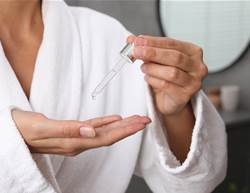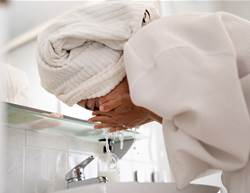From skin cycling to slugging, there’s no shortage of viral tricks promising a glowing complexion. But in reality, a solid nighttime skincare routine—and sticking to it—is all you really need.
“A nighttime routine focuses on repair and recovery, as the skin regenerates while you sleep,” explains board-certified dermatologist Dr Marisa Garshick. It’s also the ideal time to cleanse away the day and apply targeted treatments, acne medications or active ingredients that aren’t suitable for daytime use (looking at you, retinol and retinoids), adds board-certified dermatologist Dr Caroline Opene.
While there are a few guidelines to keep in mind, “skincare is highly personal and there are few one-size-fits-all recommendations,” says Dr Opene. Your evening routine should reflect your own skin goals and preferences. You might keep it simple with just the essentials, add a few extra steps like toners and serums, or turn it into a calming, at-home facial.
Whatever your style, following a consistent nighttime routine helps keep your skin clean while supporting overnight repair and renewal. Read on for expert-backed tips to build a routine that works for you.
Nighttime skincare routine steps
The order in which you apply your skincare matters. Applying your products in the right sequence helps your skin absorb them properly and maximises their effectiveness. The rule of thumb? Go from lightest to heaviest. “In general, I have my patients apply their products from thinnest—like serums or toners—to thickest, like creams,” says Dr Opene.
Below, experts break down the key steps for a nighttime routine that supports repair, hydration and glow while you sleep.
Cleanser
Dr. Garshick explains that gel or foaming cleansers are great options for those with oily skin while those with dry skin should opt for a hydrating or cream cleanser.
Washing your face at night is one of the best things you can do for your skin. “It removes makeup, dirt and oil to prepare your skin for treatments,” says Dr Garshick. If you wear makeup, consider double cleansing—starting with an oil-based cleanser, followed by a second formula that suits your skin type.
Gel or foaming cleansers are ideal for oily or acne-prone skin, while cream or hydrating cleansers are better for dry or sensitive types, Dr Garshick adds.
Toner
Toners aren’t essential for everyone, but they can be useful if your skin needs extra hydration or if you’re using actives. Apply toner straight after cleansing. It’s typically the lightest product in your routine, making it the first to go on.
Serum
Serums are where you can target concerns like dryness, dullness, breakouts or signs of ageing. “If you’re using multiple serums, apply them from thinnest to thickest,” says Dr Garshick. Go easy on actives—using too many exfoliating or strong ingredients at once can lead to irritation.
Treatment
This step is for your prescription topicals, retinol, or other intensive products. Apply them after serum—or skip the serum and go straight to treatment if you prefer. “You can also layer a hydrating serum before your retinoid, but avoid combining it with another exfoliating product,” says Dr Garshick.
Retinoids are powerful ingredients that speed up cell turnover, help prevent breakouts and reduce pigmentation. Dr Opene suggests using them three times a week. On alternate nights, try a chemical exfoliant like glycolic or lactic acid to even out texture and tone.
If your treatment feels too harsh, Dr Opene recommends applying moisturiser first to buffer the impact—especially for those with sensitive skin.
Eye cream
The skin around your eyes is thinner and more delicate, which is why it benefits from specific care. “Now’s the time to target concerns like puffiness or dark circles,” says Dr Garshick. Look for formulas with hyaluronic acid for hydration, peptides or retinol for fine lines, and ingredients like vitamin C or niacinamide for brightness. Dab it on gently using your ring finger to avoid tugging.
Moisturiser
Your final step seals everything in. “Apply a moisturiser to replenish the skin barrier and lock in hydration,” says Dr Opene. Go for a lightweight gel or lotion if you have oily or acne-prone skin, or choose a richer cream if your skin is dry or sensitive.
What is a basic skincare routine?
When it comes to skincare, sometimes simple really is best. If you prefer a more pared-back approach at night, there are just two non-negotiables. “You only need a cleanser to remove build-up from the day and a moisturiser to help nourish the skin,” says Dr Garshick.
If you have a specific skin concern—like breakouts, dryness or pigmentation—Dr Garshick recommends adding just one targeted product, such as a serum or cream with an active ingredient that addresses your individual needs.
The key is consistency. A basic, well-chosen routine done regularly can still deliver great results without overcomplicating things.









